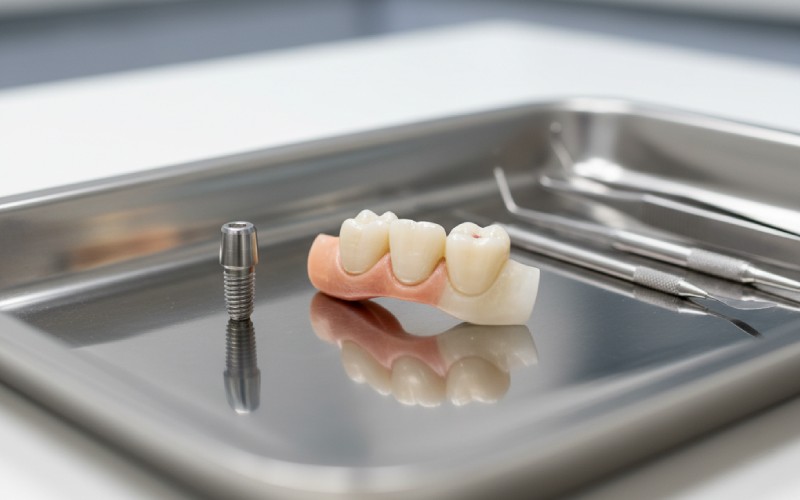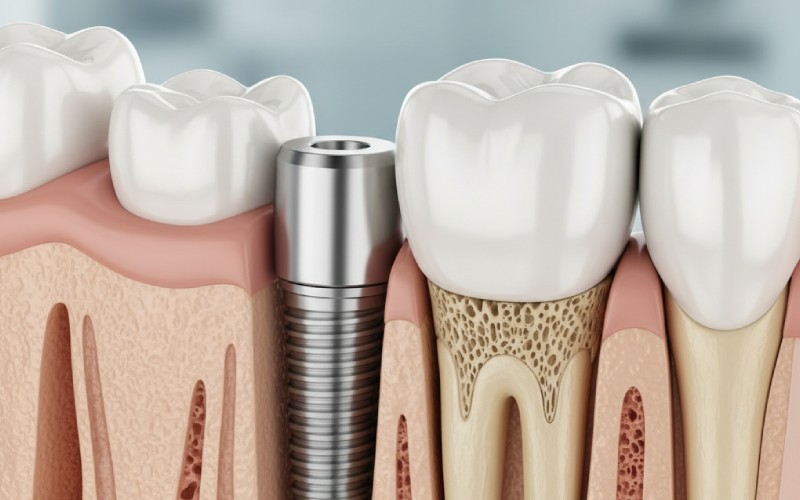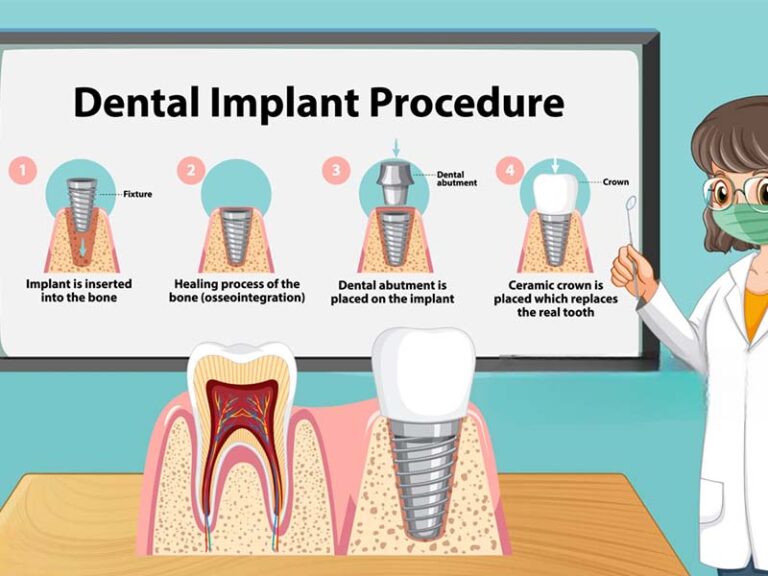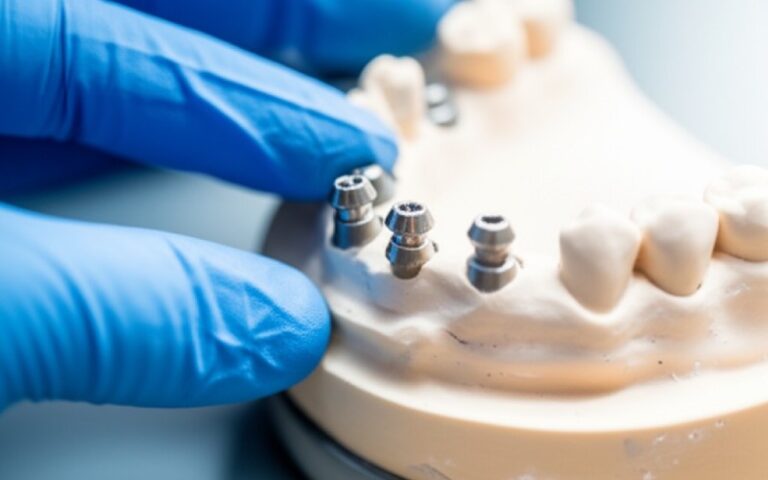
Can One Dental Implant Work for Two Teeth? A Smart Option for Your Smile
You are missing two teeth that sit next to each other. You know you need to get them replaced. But the thought of getting two separate dental implants can seem like a big deal. It sounds like it will take a lot of time, many visits to the dentist, and a high cost. What if there was a different way? What if you could use just one implant to fill the space of two teeth? It might sound like it is not possible, but it is a real choice in dentistry today.
This article is for you if you want to find out about your teeth replacement options. We will explain in easy words how one dental implant can hold up two new teeth. You will learn how it is done, if it is a good choice for you, and what your other choices are. Reading this will help you choose what is best for your health and your smile.
Indholdsfortegnelse
What Happens When You Are Missing a Tooth?
When you are missing a tooth, it is more than just an empty space in your smile. A missing tooth can lead to many problems for the health of your mouth. First, the teeth on each side of the empty space might start to move out of place. This can mess up your bite and make it harder to chew your food. After a while, this moving can make other teeth crooked. This can cause even more problems, and you could even lose another tooth.
Losing a tooth also has an effect on your jawbone. The root of a natural tooth helps keep your jawbone healthy and strong. When you miss a tooth, the bone in that spot has nothing to do. Your body then starts to remove bone from that area. This can make your jawbone get weaker and can even change the look of your face. This is why it is so important to replace a missing tooth as soon as you are able. It helps to keep your smile looking good and your whole mouth healthy.
What Is a Dental Implant, and How Does It Replace a Lost Tooth?
A dental implant is a little, strong post that is made from titanium. You can think of it as a man-made tooth root. A dentist will place the dental implant into your jawbone right where your tooth is missing. In a few months, the implant and your jawbone will join together. This process is called osseointegration. It makes a very strong spot for a new tooth to sit. A dental implant is made to feel and work just like the root of a real tooth.
After the dental implant is safe in your jaw, the dentist puts on a small connecting piece. This piece is called an abutment. The abutment is on top of the implant, just past the gum. Last, a crown that is made just for you is put on top of the abutment. The crown is built to look and feel just like your other teeth. A single dental implant is usually used to replace one tooth. This is a very normal and successful treatment. It helps a patient get their smile back and helps them chew again.

Can a Single Implant Really Hold Up More Than One Tooth?
Yes, it is true. A single implant can hold up more than one tooth. One dental implant is normally used to replace one tooth. But dentists today have found smart ways to make it do more work. This is very good news for any patient who is missing two or more teeth in a line. You do not always need to get one dental implant for every single tooth you are missing. This can make the whole treatment much easier.
The main idea is to use the dental implant as the main support for a dental bridge. Instead of putting in one implant for each tooth, we can use one implant to hold up new teeth that cover the space of two teeth. This is a wonderful option that can save you time and lower the total cost of the treatment. This method shows how we can use one strong post to hold up something bigger.
How Does the “One Implant for Two Teeth” Choice Work?
The method used to replace two teeth with one implant is named an implant-supported bridge. This is not like traditional bridges which use your own natural teeth for support. With this method, the dental implant does all of the heavy lifting. A dentist puts one dental implant into the jawbone where one of the missing teeth was. This implant will be the strong support for the bridge.
After the dental implant has had time to heal, a special piece with your new teeth is made. This is not just one crown. It is a piece that has two crowns joined together. One of these crowns will fit right over the abutment on your dental implant. The second crown is called a “pontic.” It is made to fill the empty space of the second missing tooth. The pontic does not have a root or an implant under it. It just sits nicely on your gum. This gives a very natural look, and it will seem like you have two new, separate teeth. This is how we can use one implant for two teeth.
Is an Implant-Supported Bridge a Good Choice for Every Patient?
This is a very good question to ask. The “one implant for two teeth” option is not the best choice for every patient. Your dentist will need to check a few things to see if this is a good choice for you. The most important thing is the health and thickness of your jawbone. You must have enough strong bone for the dental implant to hold on to. The implant needs to be very steady because it will be doing the job of two teeth.
Where the missing teeth are located is also important. This method is best when you need to replace smaller teeth. For example, it works well for the teeth in the front of your mouth. These teeth do not have to do as much hard chewing as your back teeth, the molars. For molars, which do a lot of chewing, a dentist will usually say it is better to have one dental implant for each missing tooth. You will need a full check-up and talk with your dentist, which might include an x-ray, to see if this treatment is right for you.
What Are the Steps in This Dental Implant Process?
The process to get one implant to hold up two teeth is very clear. It takes a few visits to the dentist over a few months. This is what you can plan for:
- Step 1: The First Talk. Your first visit is for a consultation with your dentist. You will talk about all your teeth replacement options. The dentist will take an x-ray and make a copy of your mouth. This helps them look at your jawbone and plan out the work. This is the perfect time to ask any questions you might have.
- Step 2: Putting in the Dental Implant. On your next visit, the dentist will place the dental implant into your jawbone. This is a simple thing that is done right in the office. You will be made comfortable so you do not feel it.
- Step 3: Healing Time. Now, it is time to wait. You will need about 3 to 6 months for the dental implant to join completely with your jawbone. This healing time is very important. It makes sure the implant is strong enough to hold your new teeth.
- Step 4: Getting the Bridge. When the healing is all done, you will go back for another visit. The dentist will put the abutment onto the implant. Then, they will place your special two-tooth bridge on the abutment. They will make sure it fits just right and that your bite feels good.
Are There Cheaper Teeth Replacement Options?
Yes, there are other teeth replacement options you can look at. Some of them may cost less at the start. It is good to know what they are so you can choose the best one for you.
| Treatment Option | Hvordan det gøres | Effekt på andre tænder |
|---|---|---|
| Implantat-understøttet bro | Uses one dental implant to hold up a two-tooth bridge. | Does not hurt any of your healthy natural teeth. |
| Traditionel tandbro | Uses the two healthy teeth on each side of the empty space for support. These teeth are filed down to hold crowns. | This means changing healthy teeth, which can make them not as strong over the years. |
| Delvis tandprotese | A plate you can take out that has one or more fake teeth. It usually has little clips that hold onto your natural teeth. | Can feel a bit loose sometimes and may need to be replaced more often. It does not help keep your jawbone healthy. |
Even though traditional bridges and partial dentures might seem to cost less at first, a dental implant is often a better choice for the long run. A dental implant helps keep your jawbone healthy and you do not have to change any of your other healthy teeth.
Why Pick This Method Instead of Two Single Implants?
There are a couple of big reasons why a patient might pick to use one implant to replace two missing teeth instead of getting two different dental implants. The biggest reason is usually the cost. Putting in one dental implant costs less than putting in two implants. This can make the treatment easier to pay for. It lowers the cost of the implant post, the abutment, and the time for the surgery.
Another reason is the shape of your jawbone. Sometimes, a patient has enough good bone in one spot for an implant, but not enough for a second one right beside it. In a situation like this, the one implant for two teeth option is a perfect answer. It lets the patient get new teeth that are fixed and strong, without needing more work like adding new bone. It also involves less surgery because there is only one spot to work on.
How Do I Look After My New Smile So It Lasts?
Looking after your new implant-supported bridge is very important. If you take good care of it, it can last for years and years. The good part is that you can care for it in a lot of the same ways you care for your natural teeth. You will need to brush two times a day and be sure you clean around where the new teeth meet the gum. It is also very important to clean under the bridge.
Your dentist will teach you how to use special tools. These could be a water flosser or a special kind of floss. These tools help you clean under the part of the bridge that sits on your gum. This helps get bits of food out and keeps your gums healthy. You also need to keep going to your regular dentist visits. These visits let your dentist check on the dental implant and the bridge to make sure everything is okay. Good mouth health will help your new smile look perfect for a long, long time.

How Can I Get a Perfect Smile with a Dental Implant?
If you have missing teeth and want to get your perfect smile back, the very first thing to do is to book a talk with a dentist who knows a lot about dental implants. Not all teeth replacement options are right for every person, and a dentist can help you pick the best way for you. During your first visit, you can talk about what you want, how much you can spend, and your general health.
Do not wait any more time to take care of your missing tooth or teeth. A lovely and healthy smile can be yours. A dental implant can give you a strong, long-lasting answer that looks just like your real teeth. Call today to book your appointment. Let us help you find the right treatment to get your smile back and help you feel good about it.
Vigtige ting at huske
- Yes, it is possible for one dental implant to hold up two teeth with something called an implant-supported bridge.
- This choice can be a good way to spend less money when compared to getting two separate implants.
- It is not the right choice for every person. You must have a healthy jawbone, and it is best for certain teeth in your mouth.
- The process includes placing one dental implant, letting it heal, and then attaching a bridge with two teeth.
- Other teeth replacement options are traditional bridges and partial dentures, but they have their own good and bad points.
- Good mouth care is the most important thing to make your new dental implant and bridge last for many years.
- The best way to find out if this is the right choice for you is to book a visit to talk with your dentist.




